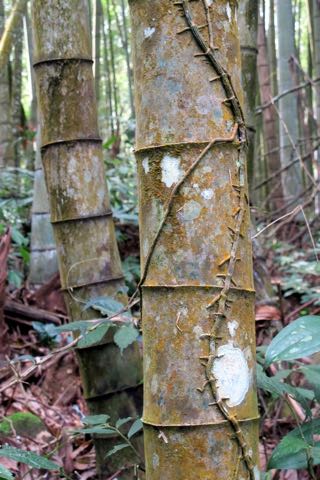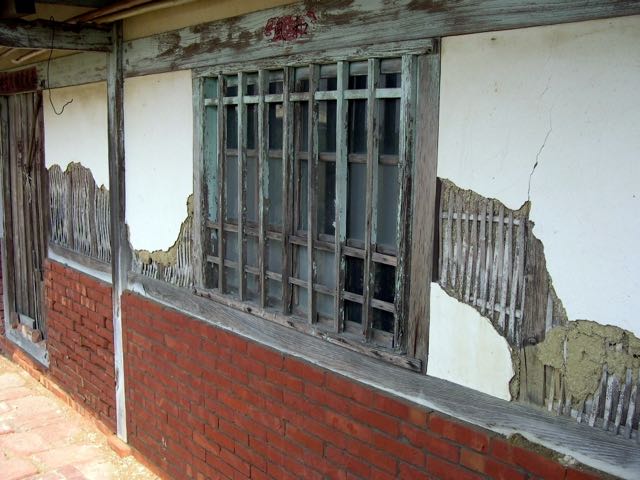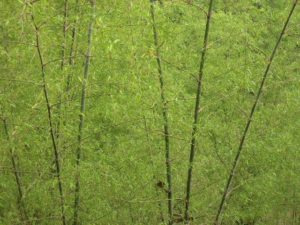
A bamboo forest near Alishan, Taiwan.
If you visit Taiwan, you’ll notice bamboo is used in countless different ways. Bamboo scaffolding is put up when houses are being repaired or repainted. Alongside highways, bamboo poles hold up advertisements. On the southwestern coast, oysters are raised on bamboo frames. Effigies of gods, carried through the streets during folk-religion processions, are held aloft on bamboo palanquins.
In the Taiwan of yore, this type of grass was used to make farmers’ hats; panniers and baskets; pushchairs and babies’ cribs; toys for children; cages for keeping pet birds and taking chickens to market; the yokes attached to water buffalo when they ploughed fields; ladles, cups and other utensils; and even musical instruments such as flutes and xylophones. Even now, the large disks used during marriage rites to shade the bride’s head are invariably made of bamboo.
Bamboo buildings

As this old house decays, bamboo wattling is exposed.
Many countryside houses built before the 1960s have wattle-and-daub walls. The wattle consists of bamboo slats; the daub is a mix of mud, rice husks and pig dung.
Bamboo furniture is still popular. Workshops that make and sell bamboo stools and chairs can be found throughout Taiwan, even in small towns like Zhushan in Nantou County. Zhushan literally means ‘bamboo mountain’, so it’s hardly surprising that manufacturing things out of this material used to be a major industry in that part of Taiwan.
Of the 1,000-plus bamboo species in the world, around 60 thrive in Taiwan. Of these, five – Makino bamboo, thorny bamboo, Moso bamboo, Ma bamboo and long-shoot bamboo – are the types most often used.[divider_flat]
Taiwan’s most beautiful bamboo forests
Stunning groves of green-leaved bamboos aren’t hard to find in mid-level mountains if you take a back road to Alishan, and they’ve been impressing Western visitors to Taiwan since at least 1871, when Scottish photographer John Thomson toured the island’s south and took some of the very first photos of the region. Thomson, later the British royal family’s official photographer, said of one remote valley: “Perhaps the bamboos were the most remarkable feature in the scene, for the plants here attain exceptional proportions… some of them [are] more than 100 feet high… [one species] being reported to attain the enormous girth of two feet.”

Lushly green bamboo in south Taiwan.
Bamboo is also useful in the kitchen. The shoots can be eaten after simmering for an hour or so; they’re delicious served cold with mayonnaise. Sticky rice dumplings (known in Mandarin as rouzong or zongzi) are wrapped in bamboo leaves; the circular boxes in which they and many other Taiwanese delicacies (mantou, guabao and so on) are steamed are usually made of bamboo.
Green, in both senses of the word
Disposable chopsticks are often made of pulped bamboo, but generally bamboo is considered an environmentally-friendly material. In addition to nurturing diverse ecosystems which include birds and butterflies, bamboo captures a great deal of carbon because it grows so quickly.
A word of warning to visitors who are thinking of taking some bamboo souvenirs back home. Items that look durable in Taiwan might warp or split if shipped to a country with a cooler, dryer climate.
